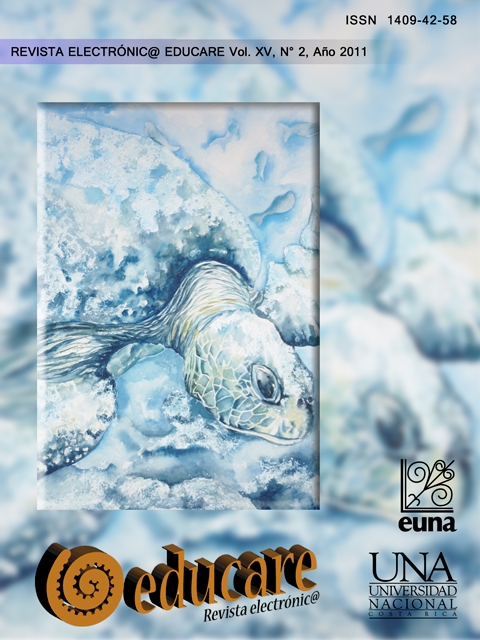Creativity in Lif
DOI:
https://doi.org/10.15359/ree.15-2.17Keywords:
Creativity, aesthetic, art, cognition, music, literature, cinematographyAbstract
In this paper, the author explains the following ideas: that creativity is not restricted to the sphere of art, as it is usually considered, since art is just an expression of creativity; that people do many things that require creativity; and that not even creativity is an attribute of humans, since, from certain critical levels, we may observe behaviors in living beings that involve different degrees of aesthetic cognition.
References
Bohm, D. y Peat, D. (1998). Ciencia, orden y creatividad. Las raíces creativas de la ciencia y la
vida (2ª ed.). Barcelona: Editorial Kairós.
Camus, A. (2005). El extranjero (12ª impresión). España: Emecé.
Half, S., Witt, J. y Thomas, T. (Productores) y Weir, M. (1989). La sociedad de los poetas muertos
[Película]. Estados Unidos: Touchstone Pictures
Hesse, H. (1978). Demian. Germany: Compañía General de Ediciones México.
Jaspers, K. (1966). La filosofía. México: FCE.
Morin, E. (2002). La cabeza bien puesta. Buenos Aires: Nueva Visión.
Swimme, B. (1998). El universo es un dragón verde. Un relato cósmico de la creaión (2ª ed.).
Santiago: Sello Azul.
Umbral, F. (2008). Comentario. Fotolog. Recuperado de http://www.fotolog.com/kens0ul/26332582
van Gogh, V. (1886), Un par de zapatos. Recuperado de http://www.reproarte.com/cuadro/
Vincent+van_Gogh/Un-par+de+zapatos/5128.html
Downloads
Published
How to Cite
Issue
Section
License
1. In case the submitted paper is accepted for publication, the author(s) FREELY, COSTLESS, EXCLUSIVELY AND FOR AN INDEFINITE TERM transfer copyrights and patrimonial rights to Universidad Nacional (UNA, Costa Rica). For more details check the Originality Statement and Copyright Transfer Agreement
2. REUTILIZATION RIGHTS: UNA authorizes authors to use, for any purpose (among them selfarchiving or autoarchiving) and to publish in the Internet in any electronic site, the paper´'s final version, both approved and published (post print), as long as it is done with a non commercial purpose, does not generate derivates without previous consentment and recognizes both publisher's name and authorship.
3. The submission and possible publication of the paper in the Educare Electronic Journal is ruled by the Journal’s editorial policies, the institutional rules of Universidad Nacional and the laws of the Republic of Costa Rica. Additionally, any possible difference of opinion or future dispute shall be settled in accordance with the mechanisms of Alternative Dispute Resolution and the Costa Rican Jurisdiction.
4. In all cases, it is understood that the opinions issued are those of the authors and do not necessarily reflect the position and opinion of Educare, CIDE or Universidad Nacional, Costa Rica. It is also understood that, in the exercise of academic freedom, the authors have carried out a rogorous scientific-academic process of research, reflection and argumentation thar lays within the thematic scope of interest of the Journal.
5. The papers published by Educare Electronic Journal use a Creative Commons License:















 The articles published by Educare Electronic Journal can be shared with a Creative Commons License:
The articles published by Educare Electronic Journal can be shared with a Creative Commons License: 



